The Effect of Land Consolidation Projects on Carbon Footprint
Abstract
:1. Introduction
2. Materials and Methods
2.1. Study Area
2.2. The Framework for Carbon Footprint Assessment of LC
2.3. Calculation Procedure
- : Distance between the parcel and the neighborhood center, in km,
- E = Coefficient according to the type of road,
- c = Fuel consumption according to energy requirements (light or heavy, L·km−1) (In the calculations, the type of road and the energy requirements for each travel were considered constant),
- n = Number of exploitations in each LC.
3. Results
4. Discussion
5. Conclusions
Funding
Institutional Review Board Statement
Informed Consent Statement
Data Availability Statement
Conflicts of Interest
References
- Pata, U.K.; Kumar, A. The Influence of Hydropower and Coal Consumption on Greenhouse Gas Emissions: A Comparison between China and India. Water 2021, 13, 1387. [Google Scholar] [CrossRef]
- Duan, J.; Ren, C.; Wang, S.; Zhang, X.; Reis, S.; Xu, J.; Gu, B. Consolidation of agricultural land can contribute to agricultural sustainability in China. Nat. Food 2021, 2, 1014–1022. [Google Scholar] [CrossRef]
- IPCC. Climate Change 2013. In The Physical Science Basis Working Group I Contribution to the Fifth Assessment Report of the Intergovernmental Panel on Climate Change; Stocker, T.F., Qin, D., Plattner, G.K., MMB, T., Allen, S.K., Boschung, J., Nauels, A., Xia, Y., Bex, V., Midgley, P.M., Eds.; Cambridge University Press: Cambridge, UK, 2013. [Google Scholar]
- Prastiyo, S.E.; Irham; Hardyastuti, S.; Jamhari. How agriculture, manufacture, and urbanization induced carbon emission? The case of Indonesia. Environ. Sci. Pollut. Res. 2020, 27, 42092–42103. [Google Scholar] [CrossRef] [PubMed]
- FAO. Greenhouse Gas Emissions from Agriculture, Forestry and Other Land Use; FAO: Rome, Italy, 2016. [Google Scholar]
- FAO. The State of Food and Agriculture: Climate Change, Agriculture and Food Security; FAO: Rome, Italy, 2016. [Google Scholar]
- Polat, H.E.; Manavbaşı, I.D. Determining the effects of land consolidation on fuel consumption and carbon dioxide emissions in rural area. Tarım Bilim. Derg. 2012, 18, 157–165. [Google Scholar]
- Viesturs, D.; Kopiks, N.; Melece, L.; Zakis, I. Methodological aspects for estimation of impact of modernisation of fleet of tractors upon polluting emissions in the air. In Proceedings of the 10th International Scientific Conference, Jelgava, Latvia, 26–27 May 2011; Latvian University of Agriculture: Jelgava, Latvia; pp. 201–205. [Google Scholar]
- Kirmikil, M.; Arıcı, I. The role of land consolidation in the development of rural areas in irrigation areas. J. Food Agric. Environ. 2013, 11, 1150–1155. [Google Scholar]
- Tan, S.; Heerink, N.; Kuyvenhoven, A.; Qu, F. Impact of land fragmentation on rice producers’ technical efficiency in South-East China. NJAS—Wagening. J. Life Sci. 2010, 57, 117–123. [Google Scholar] [CrossRef] [Green Version]
- Di Falco, S.; Penov, I.; Aleksiev, A.; van Rensburg, T.M. Agrobiodiversity, farm profits and land fragmentation: Evidence from Bulgaria. Land Use Policy 2010, 27, 763–771. [Google Scholar] [CrossRef]
- Kousar, R.; Makhdum, M.S.A.; Ullah, R.; Saghir, A.; Usman, S.; Sadaf, T. Empirical investigation of impact of land fragmentation on crop productivity in Punjab, Pakistan. Sarhad J. Agric. 2020, 36, 1–374. [Google Scholar] [CrossRef] [Green Version]
- Lu, H.; Xie, H.; He, Y.; Wu, Z.; Zhang, X. Assessing the impacts of land fragmentation and plot size on yields and costs: A translog production model and cost function approach. Agric. Syst. 2018, 161, 81–88. [Google Scholar] [CrossRef]
- Teijeiro, D.; Amor, M.; Doallo, R.; Corbelle, E.; Porta, J.; Parapar, J. Land consolidation through parcel exchange among landowners using a distributed Spark-based genetic algorithm. J. Supercomput. 2022, 78, 19522–19544. [Google Scholar] [CrossRef]
- Balawejder, M.; Noga, K. The influence of the highway route on the development of patchwork of plots. J. Water Land Dev. 2016, 30, 3–11. [Google Scholar] [CrossRef] [Green Version]
- Friedlingstein, P.; Andrew, R.M.; Rogelj, J.; Peters, G.P.; Canadell, J.G.; Knutti, R.; Luderer, G.; Raupach, M.R.; Schaeffer, M.; van Vuuren, D.P.; et al. Persistent growth of CO2 emissions and implications for reaching climate targets. Nat. Geosci. 2014, 7, 709–715. [Google Scholar] [CrossRef]
- Han, Y.M.; Long, C.; Geng, Z.Q.; Zhang, K.Y. Carbon emission analysis and evaluation of industrial departments in China: An improved environmental DEA cross model based on information entropy. J. Environ. Manag. 2018, 205, 298–307. [Google Scholar] [CrossRef] [PubMed]
- Labeckas, G.; Slavinskas, S. The influence of fuel additives S0-2E on diesel engine exhaust emission. Transp. J. 2003, 8, 202–208. [Google Scholar] [CrossRef] [Green Version]
- Kılıç, M.Y.; Dönmez, T.; Adalı, S. Karayolu ulaşımında yakıt tüketimine bağlı karbon ayak izi değişimi: Çanakkale örneği. Gümüşhane Üniversitesi Fen Bilim. Enstitüsü Derg. 2021, 11, 943–955. [Google Scholar]
- Luo, W.; Timothy, D.J. An assessment of farmers’ satisfactio with land consolidation performance in China. Land Use Policy 2017, 61, 501–510. [Google Scholar] [CrossRef]
- Akkaya Aslan, Ş.T. Evaluation of land consolidation projects with parcel shape and dispersion. Land Use Policy 2021, 105, 105401. [Google Scholar] [CrossRef]
- Gonzalez, X.P.; Marey, M.F.; Alvarez, C.J. Evaluation of productive rural land patterns with joint regard to the size, shape and dispersion of plots. Agric. Syst. 2007, 92, 52–62. [Google Scholar] [CrossRef]
- Crecente, R.; Álvarez, C.; Fra, U. Economic, social and environmental impact of land consolidation in Galicia. Land Use Policy 2002, 19, 135–147. [Google Scholar] [CrossRef]
- Wu, Z.; Liu, M.; Davis, J. Land consolidation and productivity in Chinese household crop production. China Econ. Rev. 2005, 16, 28–49. [Google Scholar] [CrossRef]
- Kolis, K.; Hiironen, J.; Riekkinen, K.; Vitikainen, A. Forest land consolidation and its effect on climate. Land Use Policy 2017, 61, 536–542. [Google Scholar] [CrossRef]
- Stręk, Ż.; Noga, K. Method of Delimiting the Spatial Structure of Villages for the Purposes of Land Consolidation and Exchange. Remote Sens. 2019, 11, 1268. [Google Scholar] [CrossRef] [Green Version]
- Huang, Q.; Li, M.; Chen, Z.; Li, F. Land consolidation: An approach for sustainable development in rural China. AMBIO A J. Hum. Environ. 2011, 40, 93–95. [Google Scholar] [CrossRef] [PubMed] [Green Version]
- Long, H. Land consolidation: An indispensable way of spatial restructuring in rural China. J. Geogr. Sci. 2014, 24, 211–225. [Google Scholar] [CrossRef]
- Song, W.; Pijanowski, B.C. The effects of China’s cultivated land balance program on potential land productivity at a national scale. Appl. Geogr. 2014, 46, 158–170. [Google Scholar] [CrossRef]
- Demetriou, D. The assessment of land valuation in land consolidation schemes: Themed for a new land valuation framework. Land Use Policy 2016, 54, 487–498. [Google Scholar] [CrossRef]
- Zhou, Y.; Guo, L.; Liu, Y. Land consolidation boosting poverty alleviation in China: Theory and practice. Land Use Policy 2019, 82, 339–348. [Google Scholar] [CrossRef]
- Ertunç, E.; Muchová, Z.; Tomić, H.; Janus, J. Legal, Procedural and Social Aspects of Land Valuation in Land Consolidation: A Comparative Study for Selected Central and Eastern Europe Countries and Turkey. Land 2022, 11, 636. [Google Scholar] [CrossRef]
- Tezcan, A.; Büyüktaş, K.; Akkaya Aslan, Ş.T. A multi-criteria model for land valuation in the land consolidation. Land Use Policy 2020, 95, 104572. [Google Scholar] [CrossRef]
- Muchová, Z.; Konc, L.; Petrovič, F. Land plots valuation in land consolidation in slovakia: A need for a new approach. Int. J. Strateg. Prop. Manag. 2018, 22, 372–380. [Google Scholar] [CrossRef]
- Harasimowicz, S.; Bacior, S.; Gniadek, J.; Ertunç, E.; Janus, J. The impact of the variability of parameters related to transport costs and parcel shape on land reallocation results. Comput. Electron. Agric. 2021, 185, 106137. [Google Scholar] [CrossRef]
- Tongur, V.; Ertunç, E.; Uyan, M. Use of the Migrating Birds Optimization (MBO) Algorithm in solving land distribution problem. Land Use Policy 2020, 94, 104550. [Google Scholar] [CrossRef]
- Haklı, H.; Uğuz, H.; Çay, T. Genetic algorithm supported by expert system to solve land redistribution problem. Expert Syst. 2018, 35, 6. [Google Scholar] [CrossRef]
- Janus, J.; Ertunç, E. Towards a full automation of land consolidation projects: Fast land partitioning algorithm using the land value map. Land Use Policy 2022, 120, 106282. [Google Scholar] [CrossRef]
- Haklı, H.; Uğuz, H. A novel approach for automated land partitioning using genetic algorithm. Expert Syst. Appl. 2017, 82, 10–18. [Google Scholar] [CrossRef]
- De Vries, W.T. Social Aspects in Land Consolidation Processes. Land 2022, 11, 452. [Google Scholar] [CrossRef]
- Sert, A.; Alkan, R.M.; Ceylan, A.R.; Karagöz, Ö.; Vanlı, C. Social and Economic Monitoring and Evaluation of Land Consolidation Projects after Implementations. In Proceedings of the FIG 2018, İstanbul, Turkey, 6–11 May 2018. [Google Scholar]
- Kawasaki, K. The costs and benefits of land fragmentation of rice farms in Japan. Aust. J. Agric. Resour. Econ. 2010, 54, 509–526. [Google Scholar] [CrossRef] [Green Version]
- Hiironen, J.; Riekkinen, K. Agricultural impacts and profitability of land consolidations. Land Use Policy 2016, 55, 309–317. [Google Scholar] [CrossRef]
- Villanueva, M.P.; Colombo, S. Cost analysis of parcel fragmentation in agriculture: The case of traditional olive cultivation. Biosyst. Eng. 2017, 164, 135–146. [Google Scholar] [CrossRef]
- Janus, J.; Ertunç, E. The impact of differences in land fragmentation parameters on the planning, implementation, and evaluation of land consolidation projects. Case studies of Turkey and Poland. Comput. Electron. Agric. 2020, 179, 105813. [Google Scholar] [CrossRef]
- Bahar, S.K.; Kirmikil, M. The evaluation of agricultural landowner inputs before and after land consolidation: The Kesik Village example. Land Use Policy 2021, 109. [Google Scholar] [CrossRef]
- Shan, W.; Jin, X.; Yang, X.; Gu, Z.; Han, B.; Li, H.; Zhou, Y. A framework for assessing carbon effect of land consolidation with life cycle assessment: A case study in China. J. Environ. Manag. 2020, 266, 110557. [Google Scholar] [CrossRef] [PubMed]
- Ramírez del Palacio, O.; Hernández-Navarro, S.; Sánchez-Sastre, L.F.; Fernández-Coppel, I.A.; Pando-Fernández, V. Assessment of Land Consolidation Processes from an Environmental Approach: Considerations Related to the Type of Intervention and the Structure of Farms. Agronomy 2022, 12, 1424. [Google Scholar] [CrossRef]
- Zhou, Z.; Liu, D.; Sun, Y.; He, J. Predicting joint effects of multiple land consolidation strategies on ecosystem service interactions. Environ. Sci. Pollut. Res. 2022, 29, 37234–37247. [Google Scholar] [CrossRef] [PubMed]
- Yang, W.; Li, X.; Li, W.; Zhang, Y.; Zhang, H.; Ran, Y. Carbon effect calculation and upgrading strategy of agricultural land consolidation project in urban edge of Three Gorges Reservoir Area. Front. Chem. Sect. Green Sustain. Chem. 2022, 10, 1022644. [Google Scholar] [CrossRef]
- Erden, T.; Coşkun, M.Z.; İpbüker, C. Network analysis and transportation problems in GIS. Harit. Derg. 2003, 70, 17–32. [Google Scholar]
- Curtin, M.K. Network Analysis in Geographic Information Science: Review, Assessment, and Projections. Cartogr. Geogr. Inf. Sci. 2007, 34, 103–111. [Google Scholar] [CrossRef] [Green Version]
- Wiedmann, T.; Minx, J. A Definition of ‘Carbon Footprint’. In Ecological, Economics Research Trends: Chapter 1; Pertsova, C.C., Ed.; Nova Science Publishers: Hauppauge NY, USA, 2008; pp. 1–11. Available online: https://www.novapublishers.com/catalog/product_info.php?products_id=5999 (accessed on 6 October 2022).
- Bekiroğlu, O. Sürdürülebilir Kalkınmanın Yeni Kuralı: Karbon Ayak İzi. II; Elektrik Tesisat Ulusal Kongresi: İstanbul, Türkiye, 2011. [Google Scholar]
- Özçelik, A.; Özer, O.O. Çiftçilere Yapılan Kimyevi Gübre Desteği ve Tarımsal Faaliyette Kullanılan Mazot için Destekleme Ödemelerinin Değerlendirilmesi. Tarım Bilim. Derg. 2006, 13, 1–8. [Google Scholar]
- Reckleben, Y.; Trefflich, S.; Thomsen, H. Auswirkung der Abgasnormen auf den Kraftstoffverbrauch von Traktoren im praktischen Einsatz. Landtechnik 2013, 68, 322–326. [Google Scholar]
- Renius, K.T.; Geimer, M. Motoren und Getriebe bei Traktoren. Jahrb. Agrartech. 2013, 10, 1–12. [Google Scholar]
- Çelik, H.A. Konya Ilinde Ulaşımdan Kaynaklı Karbon Ayak izi ve Çevresel Fayda Maliyet Analizi. Master’s Thesis, Konya Teknik Üniversitesi Lisansüstü Eğitim Enstitüsü, Konya, Turkey, 2020. [Google Scholar]
- IPCC. Guidelines for National Greenhouse Gas Inventories. In Chapter 1—Introduction Prepared by the National Greenhouse Gas Inventories Programme; Eggleston, H.S., Buendia, L., Miwa, K., Ngara, T., Tanabe, K., Eds.; IGES: Kanagawa, Japan, 2006; Volume 2. [Google Scholar]
- IPCC. IPCC Guidelines for National Greenhouse Gas Inventories. Volumes 2 and 3; Houghton, J.T., Meira Filho, L.G., Lim, B., Tréanton, K., Mamaty, I., Bonduki, Y., Griggs, D.J., Callander, B.A., Eds.; Intergovernmental Panel on Climate Change (IPCC), IPCC/OECD/IEA: Paris, France, 1997; Revised 1996. [Google Scholar]
- Cienciała, A.; Sobura, S.; Sobolewska-Mikulska, K. Optimising Land Consolidation by Implementing UAV Technology. Sustainability 2022, 14, 4412. [Google Scholar] [CrossRef]
- Hiironen, J.; Niukkanen, K. Land Consolidation and Its Effect on Climate. Climate Change and Environment; FIG Working Week: Rome, Italy, 2012. [Google Scholar]
- Gečaitė, D.; Jankava, A. Environmental Impact of Land Consolidation. 2017. Available online: https://llufb.llu.lv/Raksti/Journal_Baltic_Surveying/2017/Journal_Baltic_SurveyingVol6_2017-38-44.pdf (accessed on 6 October 2022).
- Dudzińska, M.; Kocur-Bera, K. Land consolidation as the driving force behind ecological and economic development of rural areas. In Proceedings of the 9th International Conference “Environmental Engineering”, Vilnius, Lithuania, 22–23 May 2014. [Google Scholar]
- Lacour, S.; Burgun, C.; Perilhon, C.; Descombes, G.; Doyen, V. A model to assess tractor operational efficiency from bench test data. J. Terramechanics 2014, 54, 1–18. [Google Scholar] [CrossRef]
- He, P.; Li, J.; Fang, E.; de Voil, P.; Cao, G. Reducing agricultural fuel consumption by minimizing inefficiencies. J. Clean. Prod. 2019, 236, 117619. [Google Scholar] [CrossRef]
- Hiironen, J.; Niukkanen, K. On the structural development of arable land in Finland—How costly will it be for the climate. Land Use Policy 2014, 36, 192–198. [Google Scholar] [CrossRef]
- Wu, Y.; Zhou, Y.; Guo, Y.; Wang, L. The energy emission computing of land consolidation from the dual perspectives clustering method. Clust. Comput. 2017, 20, 979–987. [Google Scholar] [CrossRef]


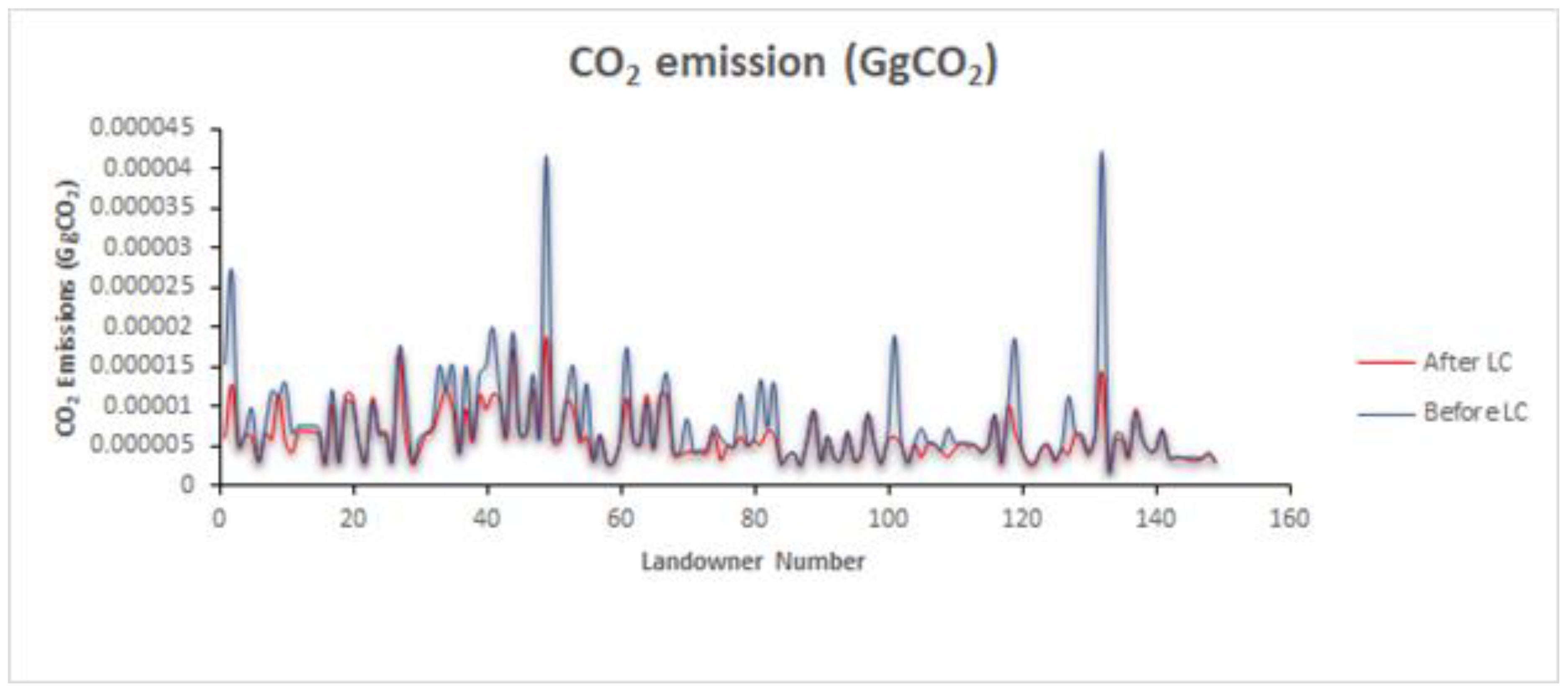

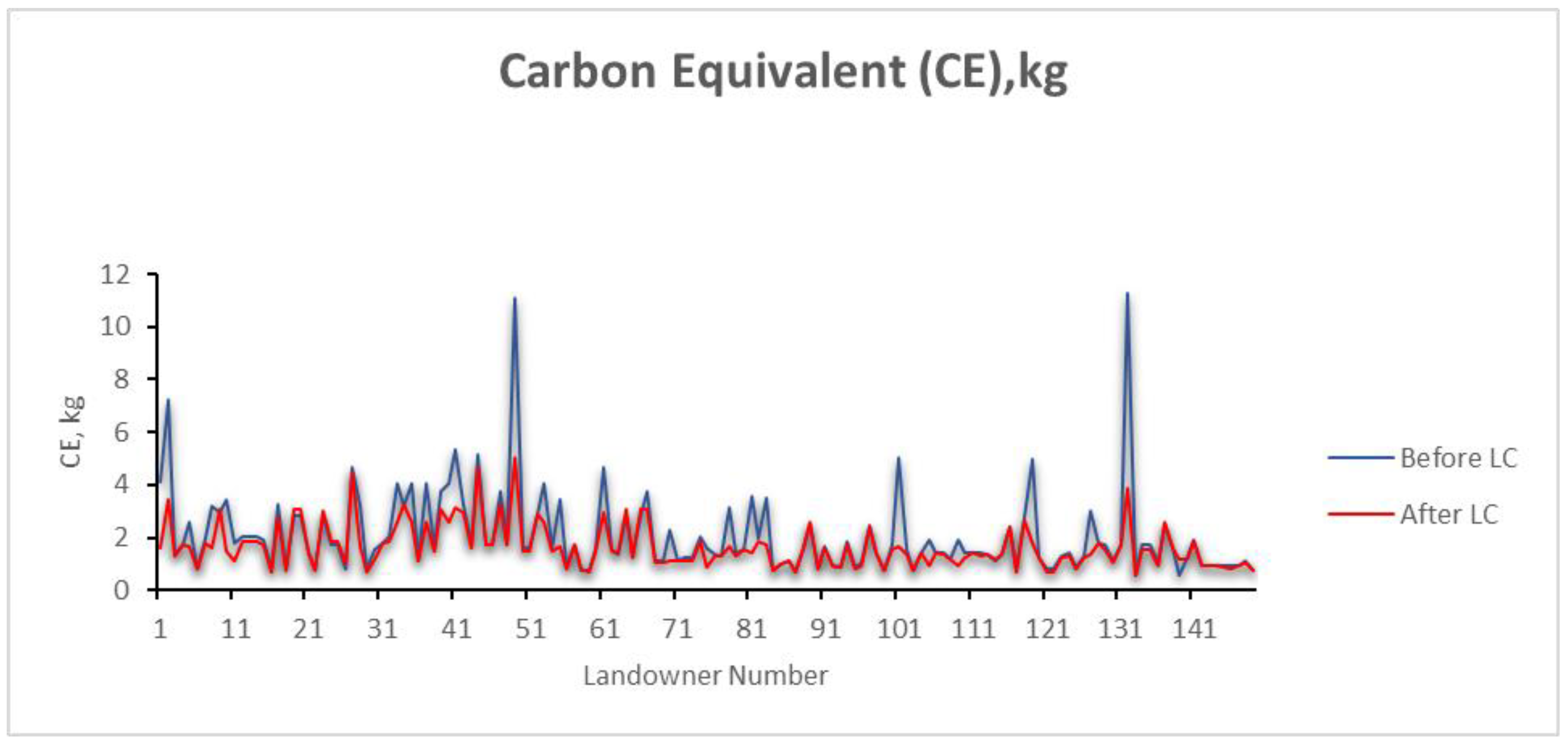
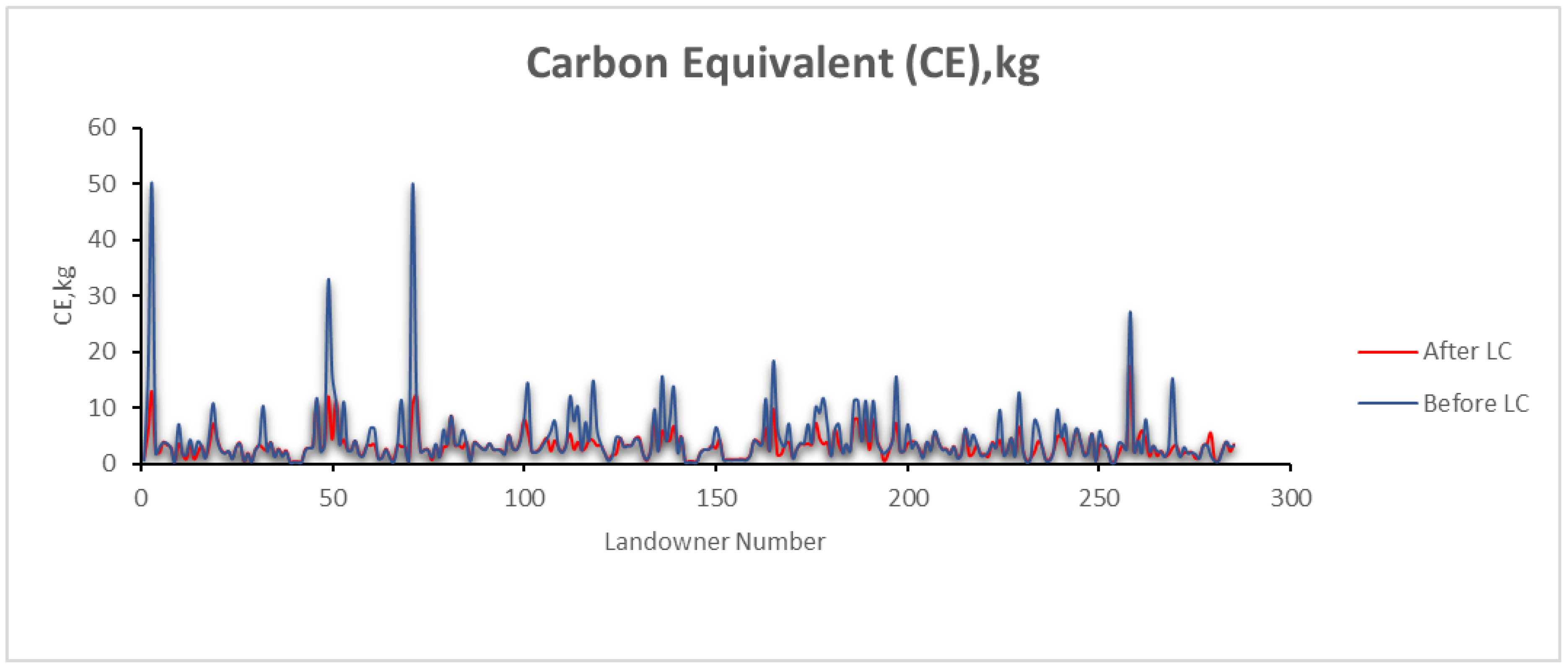

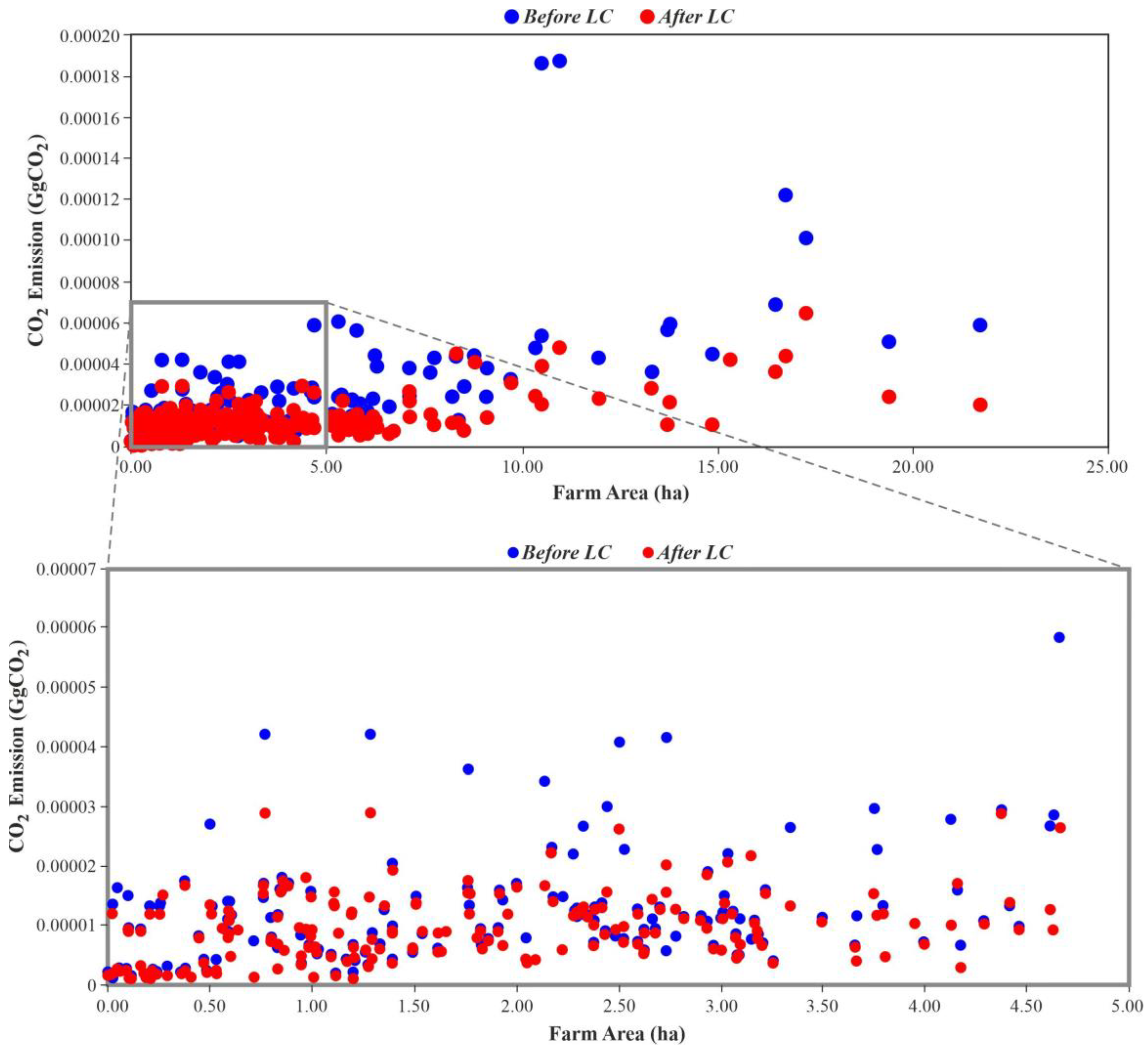

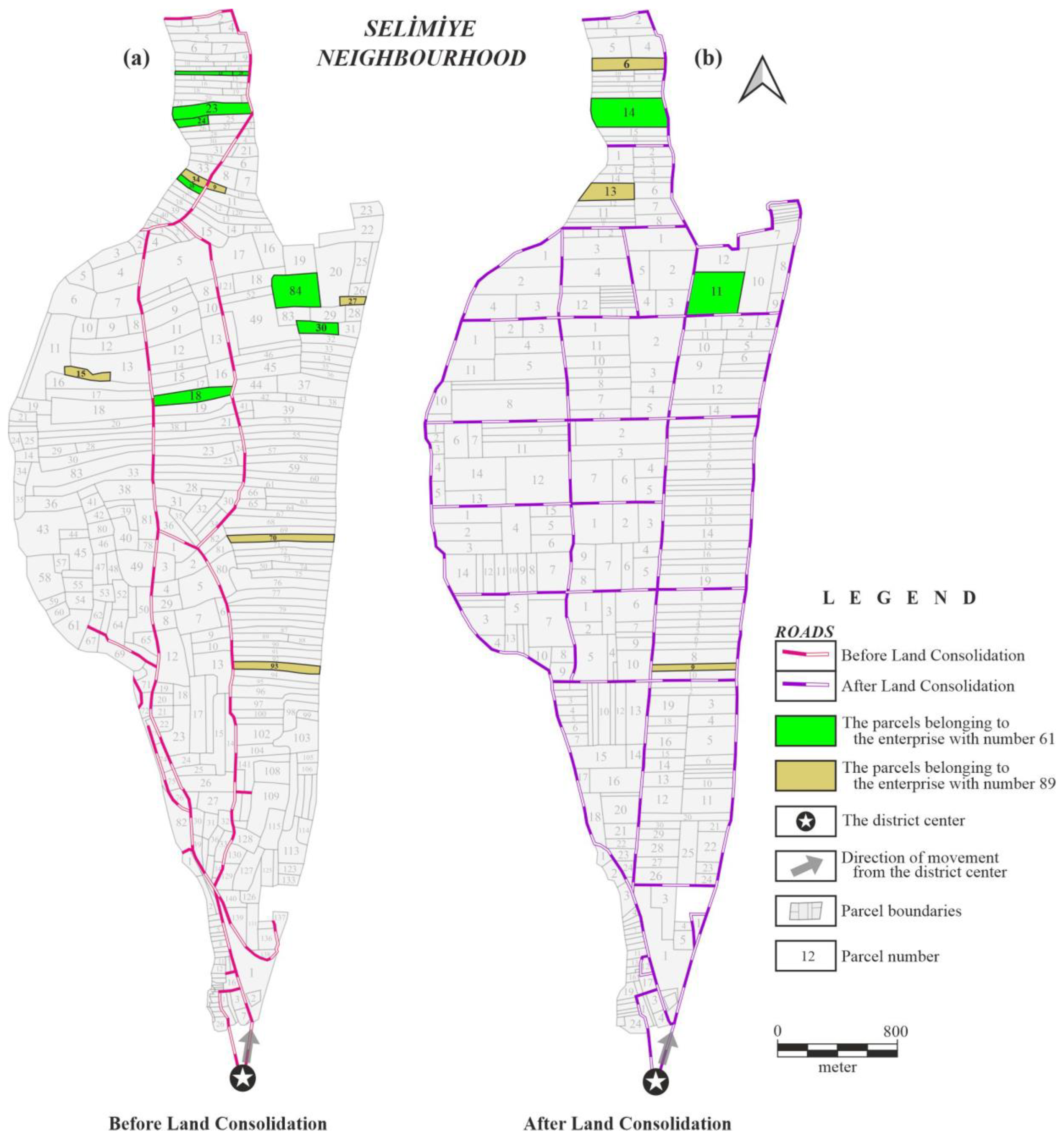
| Selimiye Neighborhood | Fatih Neighborhood | |
|---|---|---|
| Size of the Project Area (ha) | 835.66 | 289.08 |
| Number of Enterprises | 283 | 149 |
| Number of Parcels before LC | 383 | 137 |
| Number of Parcels after LC | 292 | 122 |
| Consolidation Rate (%) | 0.24 | 0.11 |
| Fuel Type | Conversion Factor (TJ/kt) |
|---|---|
| Gasoline | 44.30 |
| Diesel Fuel (Diesel) | 43.00 |
| Fuel Oil | 40.4 |
| LPG | 47.3 |
| Natural gas | 48.0 |
| Fuel Type | Carbon Emission Factor (t C/TJ) |
|---|---|
| Gasoline | 18.9 |
| Diesel Fuel (Diesel) | 20.2 |
| Fuel Oil | 21.2 |
| LPG | 17.2 |
| Natural gas | 15.3 |
Disclaimer/Publisher’s Note: The statements, opinions and data contained in all publications are solely those of the individual author(s) and contributor(s) and not of MDPI and/or the editor(s). MDPI and/or the editor(s) disclaim responsibility for any injury to people or property resulting from any ideas, methods, instructions or products referred to in the content. |
© 2023 by the author. Licensee MDPI, Basel, Switzerland. This article is an open access article distributed under the terms and conditions of the Creative Commons Attribution (CC BY) license (https://creativecommons.org/licenses/by/4.0/).
Share and Cite
Ertunç, E. The Effect of Land Consolidation Projects on Carbon Footprint. Land 2023, 12, 507. https://doi.org/10.3390/land12020507
Ertunç E. The Effect of Land Consolidation Projects on Carbon Footprint. Land. 2023; 12(2):507. https://doi.org/10.3390/land12020507
Chicago/Turabian StyleErtunç, Ela. 2023. "The Effect of Land Consolidation Projects on Carbon Footprint" Land 12, no. 2: 507. https://doi.org/10.3390/land12020507
APA StyleErtunç, E. (2023). The Effect of Land Consolidation Projects on Carbon Footprint. Land, 12(2), 507. https://doi.org/10.3390/land12020507





